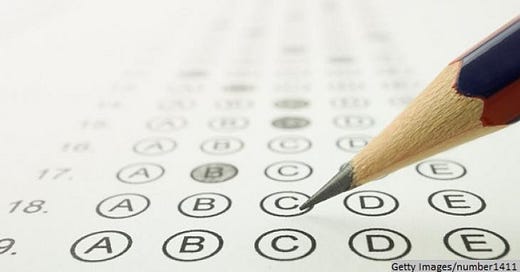Austin Scholar #140: Why school won’t help your kid get better test scores
& how I got a 1600 SAT score
Hey, y'all!
This week from Austin Scholar...
Austin’s Anecdote: How I got a 1600 SAT score
Why school won’t help your kid get better test scores
Scholar’s Sources: What I’ve been thinking about…
Another week at Stanford University has passed, and it’s still as crazy as all of the weeks before. Along with writing a 4,000 word essay and reading two books for class, I also had my second math midterm on Thursday. It’s shocking: my academically rigorous university is, in fact, academically rigorous.
On a personal level, I’ve really been trying to keep up with my friends from home, but I realized that for all of them except for one, we don’t talk unless I call them first. I know they’re busy and they still care about me, but it was still a hard thing to recognize.
Overall, though, we’re ⅔ of the way through with my first quarter at Stanford and all I can say is that it’s been a whirlwind.
Austin’s Anecdote: How I got a 1600 SAT score
This week’s article (see below!) is primarily focused on strategies to improve standardized test scores, so I thought I’d share a few personal tips on how I studied to get a 1600 on the SAT.
Practice timed tests
The time on the SAT was always my biggest problem – I would get stressed out about it and rush through passages or problems and make silly mistakes that I otherwise wouldn’t have.
So it was critical that a large portion of my study time was spent practicing the time aspect of the test. I would set a timer for my goal time (10 minutes per passage for the old SAT; for the new SAT, there’s 32 minutes to complete 27 questions, so aim for one minute per question).
Daily repetitions of one or two timed passages will help get you used to the timed aspect of the exam.
Targeted IXL lessons
Along with the daily practice, I took a few full practice tests. After each one, I went through the questions I got wrong and map them to an IXL lesson that I could use to refresh my memory (for things I didn’t know) or get better at not making careless mistakes (for things I should’ve gotten right).
IXL has a section for SAT Skill Plans, where you can see which skills are aligned with each IXL lesson in both the math and the reading and writing sections.
Formula sheets
There always seemed to be a few equations that I would get mixed up or forget how to apply, and I found myself wishing they were on the given formula sheet.
So I decided to make my own.
I wrote out everything I would’ve wanted on a formula sheet in the exam and used that as my main study material. It can seem super overwhelming when you don’t know what to study for the exam, so limiting it to one formula sheet can be super helpful.
I ended up writing the formula sheet a few times, too, so that I could get the equations in muscle memory if all else failed.
I know that a lot of students have begun preparing for the spring SAT exams right now, so I just want to wish you all luck and invite you to reach out if you have any questions on study aids for specific problems you’re having!!
Why school won’t help your kid get better test scores
It’s time to accept the harsh truth: school won’t help your kid get better test scores.
In 2022, the average fourth and eighth graders were not proficient in math, according to NAEP. (This isn’t a COVID trend – the average scores have been below proficient since the tests’ creation in 1990.)
And it’s not even that the standards are incredibly high, either. Students who are proficient in mathematics at the fourth grade level can, for example, “understand the relationships between addition, subtraction, multiplication, and division.” For eighth graders, they should be able to solve Pythagorean Theorem problems – that is, a^2 + b^2 = c^2. That’s it.
The average eighth grader in America cannot solve Pythagorean Theorem problems, and I have to wonder if it’s because the average fourth grader hasn’t mastered relationships between the four basic operations.



